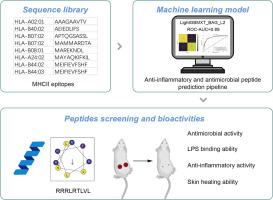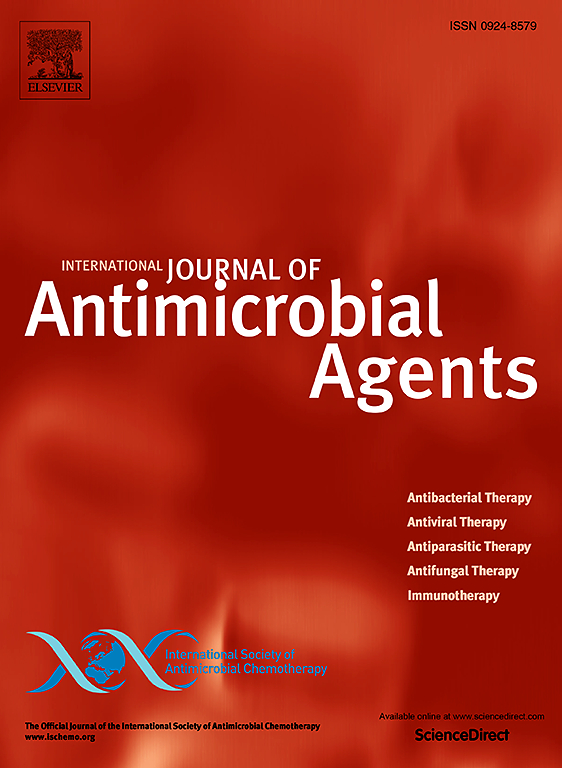机器学习加速发现抗皮肤感染的表皮双生物活性肽。
IF 4.9
2区 医学
Q1 INFECTIOUS DISEASES
International Journal of Antimicrobial Agents
Pub Date : 2024-10-31
DOI:10.1016/j.ijantimicag.2024.107371
引用次数: 0
摘要
皮肤损伤和感染是人类日常生活中不可避免的一部分,尤其是慢性伤口,已成为日益沉重的社会经济负担。在治疗皮肤感染和促进伤口愈合方面,生物活性肽可能具有很大的潜力,尤其是那些具有抗菌和消炎特性的肽。然而,仅通过传统的湿实验室实验获取这些肽既昂贵又耗时,而且目前计算机辅助预测模型识别的肽大多缺乏湿实验室实验对其效果的验证。因此,本研究旨在将计算机辅助方法与传统的湿实验室实验相结合,以鉴定抗炎和抗菌肽。我们开发了一种计算机辅助挖掘管道,从主要组织相容性复合体 II 类(MHC-II)的表位筛选潜在的多肽。我们发现了肽 AIMP1,它能通过增加细菌细胞膜的通透性对大肠杆菌造成物理损伤,并能通过与内毒素-脂多糖结合抑制炎症。此外,在 LPS 诱导的炎症动物模型中,AIMP1 会轻微升高促炎细胞因子(TNF-α、IL-1β 和 IL-6)的水平;在皮肤伤口感染动物模型中,AIMP1 能有效加速伤口愈合,降低这些促炎细胞因子的水平,并且没有急性肝毒性或肾毒性。总之,本研究不仅开发了一种用于鉴定抗炎和抗菌多肽的计算机辅助挖掘管道,还成功地找到了多肽 AIMP1,证明了它在治疗皮肤损伤方面的治疗潜力。本文章由计算机程序翻译,如有差异,请以英文原文为准。

Machine learning accelerates the discovery of epitope-based dual-bioactive peptides against skin infections
Objectives
Skin injuries and infections are an inevitable part of daily human life, particularly with chronic wounds, becoming an increasing socioeconomic burden. In treating skin infections and promoting wound healing, bioactive peptides may hold significant potential, particularly those possessing antimicrobial and anti-inflammatory properties. However, obtaining these peptides solely through traditional wet laboratory experiments is costly and time-consuming, and peptides identified by current computer-assisted predictive models largely lack validation of their effects via wet laboratory experiments. Consequently, this study aimed to integrate computer-assisted methods and traditional wet laboratory experiments to identify anti-inflammatory and antimicrobial peptides.
Methods
We developed a computer-assisted mining pipeline to screen potential peptides from the epitopes of the major histocompatibility complex class II.
Results
The peptide AIMP1 was identified, with the ability to physically damage Escherichia coli by increasing bacterial cell membrane permeability, and with the ability to inhibit inflammation by binding to endotoxin-lipopolysaccharide. Additionally, in an LPS-induced inflammation animal model, AIMP1 slightly increased levels of proinflammatory cytokines (TNF-α, IL-1β, and IL-6), and in a skin wound infection animal model, AIMP1 effectively accelerated healing, reduced levels of these pro-inflammatory cytokines, and showed no acute hepatotoxicity or nephrotoxicity.
Conclusions
In conclusion, this study not only developed a computer-assisted mining pipeline for identifying anti-inflammatory and antimicrobial peptides but also successfully pinpointed the peptide AIMP1, demonstrating its therapeutic potential for skin injury treatment.
求助全文
通过发布文献求助,成功后即可免费获取论文全文。
去求助
来源期刊
CiteScore
21.60
自引率
0.90%
发文量
176
审稿时长
36 days
期刊介绍:
The International Journal of Antimicrobial Agents is a peer-reviewed publication offering comprehensive and current reference information on the physical, pharmacological, in vitro, and clinical properties of individual antimicrobial agents, covering antiviral, antiparasitic, antibacterial, and antifungal agents. The journal not only communicates new trends and developments through authoritative review articles but also addresses the critical issue of antimicrobial resistance, both in hospital and community settings. Published content includes solicited reviews by leading experts and high-quality original research papers in the specified fields.

 求助内容:
求助内容: 应助结果提醒方式:
应助结果提醒方式:


